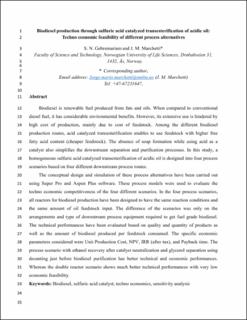| dc.contributor.author | Gebremariam, Shemelis Nigatu | |
| dc.contributor.author | Marchetti, Jorge Mario | |
| dc.date.accessioned | 2020-11-30T11:48:10Z | |
| dc.date.available | 2020-11-30T11:48:10Z | |
| dc.date.created | 2018-10-12T15:03:03Z | |
| dc.date.issued | 2018 | |
| dc.identifier.citation | Energy Conversion and Management. 2018, 174 639-648. | en_US |
| dc.identifier.issn | 0196-8904 | |
| dc.identifier.uri | https://hdl.handle.net/11250/2690185 | |
| dc.description.abstract | Biodiesel is renewable fuel produced from fats and oils. When compared to conventional 12 diesel fuel, it has considerable environmental benefits. However, its extensive use is hindered by 13 high cost of production, mainly due to cost of feedstock. Among the different biodiesel 14 production routes, acid catalyzed transesterification enables to use feedstock with higher free 15 fatty acid content (cheaper feedstock). The absence of soap formation while using acid as a 16 catalyst also simplifies the downstream separation and purification processes. In this study, a 17 homogeneous sulfuric acid catalyzed transesterification of acidic oil is designed into four process 18 scenarios based on four different downstream process routes. 19 The conceptual design and simulation of these process alternatives have been carried out 20 using Super Pro and Aspen Plus software. These process models were used to evaluate the 21 techno economic competitiveness of the four different scenarios. In the four process scenarios, 22 all reactors for biodiesel production have been designed to have the same reaction conditions and 23 the same amount of oil feedstock input. The difference of the scenarios was only on the 24 arrangements and type of downstream process equipment required to get fuel grade biodiesel. 25 The technical performances have been evaluated based on quality and quantity of products as 26 well as the amount of biodiesel produced per feedstock consumed. The specific economic 27 parameters considered were Unit Production Cost, NPV, IRR (after tax), and Payback time. The 28 process scenario with ethanol recovery after catalyst neutralization and glycerol separation using 29 decanting just before biodiesel purification has better technical and economic performances. 30 Whereas the double reactor scenario shows much better technical performances with very low 31 economic feasibility. | en_US |
| dc.language.iso | eng | en_US |
| dc.rights | Attribution-NonCommercial-NoDerivatives 4.0 Internasjonal | * |
| dc.rights.uri | http://creativecommons.org/licenses/by-nc-nd/4.0/deed.no | * |
| dc.title | Biodiesel production through sulfuric acid catalyzed transesterification of acidic oil: Techno economic feasibility of different process alternatives | en_US |
| dc.type | Peer reviewed | en_US |
| dc.type | Journal article | en_US |
| dc.description.version | submittedVersion | en_US |
| dc.source.pagenumber | 639-648 | en_US |
| dc.source.volume | 174 | en_US |
| dc.source.journal | Energy Conversion and Management | en_US |
| dc.identifier.doi | 10.1016/j.enconman.2018.08.078 | |
| dc.identifier.cristin | 1620071 | |
| cristin.unitcode | 192,15,6,0 | |
| cristin.unitname | Seksjon for realfag og teknologi | |
| cristin.ispublished | true | |
| cristin.fulltext | preprint | |
| cristin.qualitycode | 2 | |

